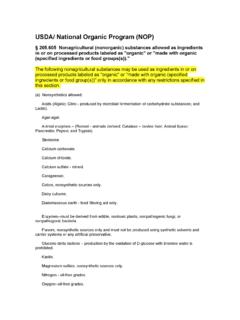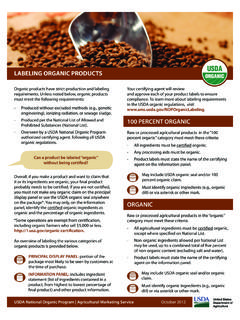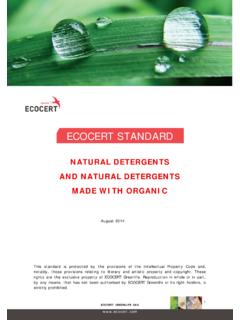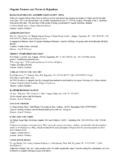Transcription of Evaluation of Employees’ Exposures to Organic …
1 Evaluation of Employees Exposures to Organic Solvent Vapors during Screen Printing Scott E. Brueck, MS, CIHH ealth Hazard Evaluation ReportHETA 2007-0053-3092 Inter Sign National IncorporatedBaltimore, Mar ylandOctober 2009 DEPARTMENT OF HEALTH AND HUMAN SERVICES Centers for Disease Control and Prevention WorkplaceSafety and Health National Institute for Occupational Safety and HealthThis Health Hazard Evaluation (HHE) report and any recommendations made herein are for the specific facility evaluated and may not be universally applicable. Any recommendations made are not to be considered as final statements of NIOSH policy or of any agency or individual involved. Additional HHE reports are available at employer shall post a copy of this report for a period of 30 calendar days at or near the workplace(s) of affected employees.
2 The employer shall take steps to insure that the posted determinations are not altered, defaced, or covered by other material during such period. [37 FR 23640, November 7, 1972, as amended at 45 FR 2653, January 14, 1980].Page iHealth Hazard Evaluation Report 2007-0053-3092Ap p e n d i x ARe p oR tAbbreviations ..iiHighlights of the NIOSH Health Hazard Evaluation ..iiiSummary ..vIntroduction ..1 Assessment ..2 Results ..3 Discussion ..7 Conclusions ..13 Recommendations ..14 References ..18Co n t e n t sAcknowledgments and Availability of Report ..25 Methods ..20 Occupational exposure Limits & Health Effects ..21AC k n o w l e d g m e n t sAp p e n d i x BPage iiHealth Hazard Evaluation Report 2007-0053-3092 ACGIH American Conference of Governmental Industrial Hygienistscc/min Cubic centimeters per minuteCFR Code of Federal Regulationsfpm Feet per minuteHHE Health hazard evaluationHVAC Heating, ventilating.
3 And air-conditioningMSDS Material safety data sheetNAICS North American Industry Classification SystemNIOSH National Institute for Occupational Safety and HealthOEL Occupational exposure limitOSHA Occupational Safety and Health AdministrationPBZ Personal breathing zonePEL Permissible exposure limitppm Parts per millionPPE Personal protective equipmentREL Recommended exposure limitSTEL Short-term exposure limitTLV Threshold limit valueTWA Time-weighted averageUL Underwriters Laboratory IncorporatedWEEL Workplace environmental exposure limitAB B Re v iA t i o n sPage iiiHealth Hazard Evaluation Report 2007-0053-3092 What NIOSH DidWe took full-shift air samples for toluene, n-hexane, isopropyl alcohol, acetone, and took short-term air samples for toluene, isopropyl alcohol, and measured airflow in the spray paint booth.
4 We used ventilation smoke tubes to check air movement in the screen printing evaluated personal protective equipment use. We identified fire safety hazards. What NIOSH FoundEmployees full-shift Exposures to toluene, n-hexane, isopropyl alcohol, acetone, and cyclohexanone did not exceed occupational exposure to the mixture of solvents slightly exceeded American Conference of Governmental Industrial Hygienists term exposure to isopropyl alcohol may exceed short term exposure limits during screen printing and screen did not always wear proper protective gloves when working with eyewear was not worn to protect against chemical thinner for daily use was not stored in approved amounts of lacquer thinner were stored in the spray paint were not properly bonded when flammable liquids were poured from one container to another.
5 What Managers Can DoInvestigate replacing solvent-based screen printing products with alternatives that have low or no ventilation in the screen printing area. Provide and require employees to wear properly fitting NIOSH-approved respirators when screen washing or printing until solvent Exposures are employees with chemical protective gloves made of Viton /butyl combination or laminate plastic National Institute for Occupational Safety and Health (NIOSH) received a management request for a health hazard Evaluation (HHE) at Inter Sign National, Inc., in Baltimore, Maryland. The HHE request concerned potential health effects from exposure to Organic solvent vapors during screen printing and spray painting. NIOSH visited the company in December 2007. Hi g H l i gH t s o f t H e niosH He A l t H HA z A Rd ev A l uA t i o nPage ivHealth Hazard Evaluation Report 2007-0053-3092Hi g H l i gH t s o f t H e niosH He A l t H HA z A Rd ev A l uA t i o n (C o n t i n u e d)Require employees to use eye protection and chemical protective gloves when handling hazardous proper flammable safety containers for storing and dispensing of daily use lacquer not permit more than a one-day supply of lacquer thinner or screen inks to be stored in the spray paint booth.
6 Require the use of bonding cables to electrically connect containers of flammable liquids when pouring from one container into a personal protective equipment hazard employees how to properly use and store personal protective a comprehensive respiratory protection program. Complete a hazard communication program to inform employees about the hazardous chemicals they could be exposed all chemical containers with identity and hazard warning the Maryland Safety and Health Consultation Program to help identify and provide recommendations to correct safety Employees Can DoWear gloves when handling hazardous chemicals. Wear safety glasses when transferring hazardous chemicals, and when using chemicals in a way that might cause chemical respiratory protection when screen printing or screen washing until ventilation in the screening areas is of lacquer-thinner-soaked cleaning towels and tissue paper into closed containers immediately after use.
7 Prepare and use only what is needed for the immediate job. Use safety containers approved for flammable liquids for daily use of lacquer bond containers when pouring flammable liquids from one container to flammable liquids in the flammable material storage vHealth Hazard Evaluation Report 2007-0053-3092On November 14, 2006, NIOSH received a request for an HHE from the management of Inter Sign National, Inc., in Baltimore, Maryland. Management of the company was concerned about potential adverse health effects from employees Exposures to Organic solvents in lacquer thinner and screen printing inks. In response to these concerns, NIOSH conducted a site visit on December 5 6, 2007. During the site visit NIOSH met with management and employee representatives, observed work activities, assessed PPE use, evaluated ventilation for the screen printing and spray painting operations, and measured Exposures to toluene, n-hexane, isopropyl alcohol, acetone, and cyclohexanone.
8 Full-shift monitoring results indicated that air contaminant concentrations for the screen printer, screen printer helper, spray painter, and an area sample in the screening area were below OELs. Additionally, exposure to the combined mixture (additive exposure ) of toluene, n-hexane, isopropyl alcohol, acetone, and cyclohexanone was low, based on NIOSH RELs and OSHA PELs. However, using ACGIH TLVs, additive exposure for the screen printer helper and the area sample indicated slight overexposure to the Organic solvent mixture, and the screen printer was nearly overexposed to the mixture of solvents. Short-term air samples for toluene, isopropyl alcohol, and acetone revealed isopropyl alcohol concentrations during screen printing and screen washing have the potential to exceed the NIOSH and ACGIH STELs. Short term concentrations of toluene and acetone were well below applicable STELs.
9 We recommend that the company investigate replacing solvent-based screen printing products with nonsolvent or low solvent observed employees leaving cleaning towels or tissue paper soaked with lacquer thinner on a work desk near the screen printing tables. Evaporation of solvents from these items can contribute to worker Exposures . We recommend that employees only use what is needed for the immediate task and promptly dispose of solvent soaked towels and tissue paper in closed containers after use. The screen printing area did not have exhaust ventilation. Ventilation smoke tubes indicated little air movement in the work area. Opening the window near the screen printing table and operating the fan at the window would improve ventilation. We noted that the window is only opened and the fan used during Full shift exposure to toluene, n-hexane, isopropyl alcohol, acetone, and cyclohexanone did not exceed OELs.
10 However, exposure to the mixture of solvents slightly exceeded the ACGIH TLV. Short term exposure to isopropyl alcohol during screen printing and screen washing could exceed STELs. Improved ventilation in the screen printing area is recommended. The use of nonsolvent or low solvent alternatives for screen printing should be investigated for m mA RyPage viHealth Hazard Evaluation Report 2007-0053-3092su m mA Ry (C o n t i n u e d)warm weather. Therefore, we recommend installing an exhaust ventilation system for screen printing. Ventilation of the spray paint booth was found to be sufficient. We recommend that all employees performing screen printing and screen washing wear NIOSH-approved respiratory protection until engineering or administrative controls reduce Exposures to the mixture of Organic solvents to below the ACGIH TLV.














